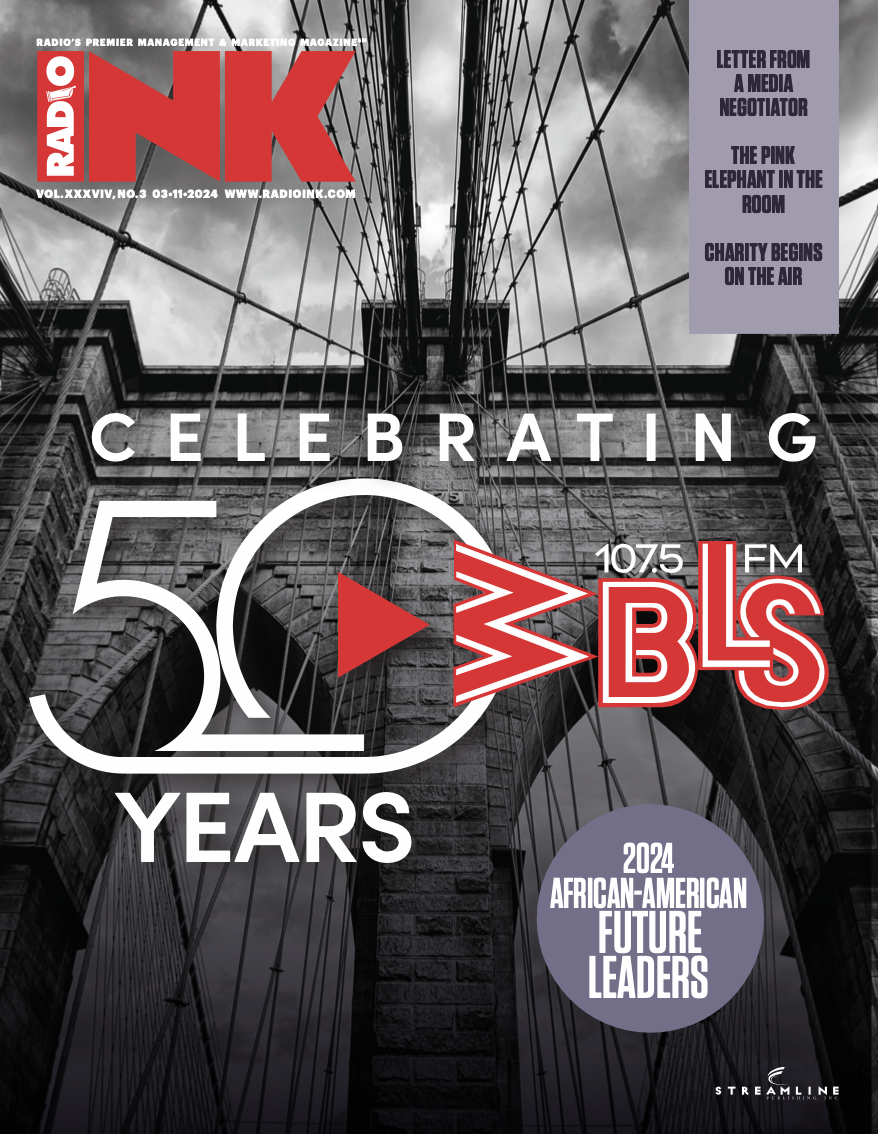
The question we raised in our headlines Tuesday launched a day-long discussion about how many commercials is too many commercials to play every hour. Let’s keep the conversation going today. If you missed our story yesterday, here it is again. Please leave your comments below.
It’s a question the radio industry has been battling for many years, but never really has addressed in a serious way, despite study after study where listeners complain about the commercial clutter. The pressure to sell more is as great as its ever been. However no matter how much you sell there are only 60 minutes in an hour, and listeners are turned off by the clutter. So how many spots is too many? Let’s find out what Dan Mason thinks.
The answer to that question, according to former CBS Radio President Dan Mason, is no more than 8 to 10 spots per hour. And, radio managers know the majority of radio stations today play way more than that. At Radio Ink’s Hispanic Radio Conference last week, Mason said with competition from streamers like Pandora, Spotify and others radio should be playing 8 to 10 units per hour. “And that’s controversial because I’m sure (CBS Executive Vice President for Programming) Chris Oliviero will call me and say “Where were you? Because we tried to get you to do that a long time ago.”
Mason told the Radio Ink audience last week that he’s not telling them how to do it, because, he says he doesn’t know how. “I’m just telling you that’s reality. Keep in mind that when FM radio came about, we were going up against AM radio. AM radio stations were fat, dumb and happy. They were making a fortune. They were running 16 to 17 minutes an hour of commercials. They were printing money in the back room. All of sudden, this thing called FM comes along and they were probably running 6 to 8 minutes an hour and listeners were like “Wow. What just happened here? I heard more music instead of all of these commercials over and over and over.” And, Mason says over time that number of commercials crept up. and now stations are running 14, 16, 15, units every hour and it’s probably too much.”
And, as for the debate over 30’s or 60’s, Mason says that doesn’t really matter. “I used to fight with our program directors all the time and say “It doesn’t make any difference. It’s time out of music.” You could play that game and think that your listeners are noticing “Oh, they ran a 30. Oh, it’s a 60. That’s really two commercials.” In my opinion, they don’t care. It’s time out of music. So it’s minutes, minutes, minutes. We used to sell just minutes back in maybe the late 70s. But the truth is, you’ve got to be more flexible. Program directors have to be more flexible. Because you’ve got to sell 30’s too. And you’ve got to sell 15’s. And you’ve got to sell 10’s. Because if there are clients out there that want to spend money, you’ve got to let your radio station take it. You have to expand your client base, because those same people that are buying 10s and 15s, if they’re successful, some day they are going to be buying 60s from you. So, you owe it to your radio station to begin to be part of developing that client base for yourself.”
In our latest Podcast, to be posted today, you’ll hear from an ad agency out of Kansas City that spends a lot of money with radio. There biggest problem with the industry — too much clutter. They do not want there clients getting buried and lost in an 10 to 12 unit commercial pod. Would they pay more for a commercial if you played fewer commercials every hour? You’ll have to tune in and listen to what they have to say.






Phil Barry is spot on (pun intended). Listeners don’t care that you overpaid for the property. Nothing speaks louder than BANKRUPTCY and we’ve seen unprecedented bankruptcies. You can’t dig your way out of a hole, and disrespecting your clients and listeners with clutter. People have choices now. I remember a time in 1976 when WSHE started every hour with a simple promise: “SHE will play at least 52 minutes of music this hour.” Corporate radio execs have killed the goose that laid the golden eggs. My teenage niece and nephew don’t own a radio nor do they EVER stream commercial radio. Welcome to the future. Again, no one cares if your company overpaid for the station. If you can’t make it on 8-10 minutes of commercials max per hour, that’s your problem.
Meanwhile, for those who can stand it, even more vitriol and abuse is provided in the blog at the bottom of the home page. (“Too Deep For Sheep”)
Commercial music-radio is a boat wreck. But only to the degree that it refuses to up its game where it needs it the most. Radio could be doing so much better.
Still, the apologists come roaring in with useless banter and no strategies for improvement.
(I have put my own methodologies forward many times – all tested and demonstrated.)
I mean, we are having a chat here about how many spots per hour would be more effective.
This is an issue that should have been put to bed decades ago. It’s “sandbox” material.
And so it is unfortunate that the really big radio brains just can’t wrap their heads around it.
Too bad. There are much bigger fish passing by.
At Radio Woodstock we are experimenting with four stops sets per hour with a maximum of 2 1/2 minutes per stopset. DJs lead into each stop set saying how long before we’ll be back to music and announce the track or tracks that will be coming up. If the stop set is shorter then we say we’ll be back in 90 seconds. In the short-term it increases our time spent listing. In the long term it builds our image for the station that we have less commercials per hour. We sell 15s, 30s and 60s and various sponsorships with shorter tags. We sell the sponsorships and commercials as a package. The shorter sponsorship tags build name awareness for the advertiser and the longer commercials provide the product or service details. Good creative is crucial. We add in digital and social media to provide interactivity and engagement.
At Radio Woodstock we are experimenting with four stops sets per hour with a maximum of 2 1/2 minutes per stopset. DJs lead into each stop set saying how long before we’ll be back to music and announce the track or tracks that will be coming up. If the stop set is shorter then we say will be back in 90 seconds. In the short-term and increases time spent listing. In the long term it builds it image for the station that we have less commercials per hour. We sell 15s, 30s and 60s and various sponsorships with shorter tags. We sell the sponsorships and commercials as a package. The shorter sponsorship tags build name awareness for the advertiser and the longer commercials provide the product or service details. Good creative is crucial. We add in digital and social media to provide interactivity and engagement.
Why is every thread hijacked by this Ronald Robinson?
I don’t know of any one station that is “doing it right” 100% of the time. I do know of hundreds of clients who are using radio effectively because their commercials are interesting, relevant, compelling, and yes, even entertaining. Many of the creators of those commercials have been trained or at least inspired by experts who have an abnormal love for telling stories that sell products and services. Stations that are prospering have invested in those experts to help their teams create more effective messages. Often these stations are running heavy spot loads. I’ve been called “The 17% Consultant” because helping broadcasters improve their commercials and promos (which the audience hears as part of programming) improves TSL. Better spots = more attractive programming = higher ratings = more revenue.
Some of us remember, pre-deregulation, when 18 minutes of ads per hour were “allowed” by the FCC. We carefully counted up the ad minutes on the logs the day before to make sure that we weren’t in violation. I don’t remember anyone complaining about the ad volume except for maybe the traffic girl.
It can’t help the mental state of ad salespeople when so many complain about what they sell. It’s bad enough to face a hostile marketplace all day, then come back to the office and have program people and clerks critical of the ads sold that day. Those ads pay overhead and pay salaries. Learn to respect them.
Yes 18 is correct except at Christmas time they let us increase to 22 minutes per hour! My old boss would say, “get the shoe horn out”!!! Kind of amazing as that AM daytimer owned the marketplace! Real Radio! That station is now owned by Live and Local Alpha media! Keep it going Larry!
salesguy is right. Ronnie, hilariously, keeps whining that no one factually contradicts his opinions-all subjectivity. HE is the one that never points to a success story, a station that is doing it right. I asked him to name one- a station that sounds the way he thinks it should-he could not. To Ron Robinson, all 13,000 American radio stations sound like trash. Now, that is arrogance.
I’m comfortable with commercial breaks being the length of song…. no more than 3 minutes,
not units…minutes.
Four breaks an hour… Twelve minutes an hour. Prioritize your breaks for maximum music flow.
Sell ’em out and raise your rates !!! Supply and demand.
“Feels like people missing the point, intentionally.”
Nothing intentional about it Mr. Math. Very few would be so superficial or willingly display such lack of knowledge or understanding. There’s a sackload of sincerity on display.
It’s about the uniformed lashing out when their realities are being challenged.
When they cannot dispute the content, they slander the content provider.
Its all so typical – and tiresome.
The propositions are: Radio spots suck. There are too many of them. They are poorly placed in a programming hour.
Nobody has come up with any reasonable counter-arguments to those propositions =- for decades.
Isn’t is fun when an academic tells those of us in the business that he isn’t how to run it?
Note to Rick and Shelly: Seriously?
Why are some of you “radio” folks referring to radio commercials as “ads. Ads are in newspapers & magazines, commercials are spots. Circa LACC class of 1972, Broadcast Department Chairman, Dr. Don Mc Call.
It hasn’t been 1972 for about 44 years now. Ads, spots, commercials, call them what you want, they’re all advertising. Circa reality, Department of Obvious, Dr. Sum Serious.
This is the best response the industry can muster? To debate what different regions/markets/countries call commercials? Feels like people missing the point, intentionally.
Every time Ronnie gets cornered and bested he runs to his thesaurus and barfs out never-used synonyms. Sort of an effete snob pulling rank on the unenlightened masses whom he despises.
Indeed, a subjective conversation it has to be.
Nevertheless, I will continue to insist the vast majority of cobbled-together ads are pure crap, and for all the reasons I have posited elsewhere.
Defending the weakest portion of the status quo is a dynamic demonstration of delusional posturing. It doesn’t stand up.
It also bodes poorly for making any outfit making attempts at generating massive and necessary improvements in spot production.
Besides, asking listeners what they like is a mug’s game. With respect (really) they don’t know if they are punched or bored.
The more important piece of research is about finding out: To what advertising, specifically, will the audience respond most powerfully?
Advertising is far more sophisticated than seeking approvals would divulge anyway. Seeking approvals or avoiding generating offense only crushes competency and creative.
Time for radio to join other mature media.
This subjective conversation has been going on for 40 years with no conclusion ever in sight because it is…..subjective. (Are silver cars the prettiest?)
Look at Robinson’s adjectives–” unlistenable, irritating, innocuous, pandering, intolerable, worst, terrific.” All in one paragraph. All subjective to Ron only.
Sorry programmers-Thorough research performed by the Welsh Company in Tulsa Oklahoma many years ago documented that listeners LIKE local ads; over 62% LIKE them A LOT. Play as many as you can sell. Stations with a healthy spot load have the highest ratings
You are playing my tune!!! Play on!
Hello! Last Fall, I was on a sabbatical and studied the spot loads and commercial clusters on music radio. The results of my study were published in the Huffington Post Online and the News & Observer here in Raleigh. I think you may be interested to look at my research. I will be happy to forward a link. Just let me know.
Very truly yours, Doug Spero, Associate Professor of Mass Comm. Meredith College, Raleigh, NC
919-760-8092.
I’ve always found, as a 20 year industry veteran, two big problems when it comes to commercials on the radio.
1) as Ronald pointed out, a lot of the local ads are just bad. Horrible. And the reason is normally that whoever is tasked with writing them is in no way qualified to write an effective ad. They’re very often sales people who think ads need to sound like ads – or worse, listen to what the client thinks is a great idea, slaps it on paper, and tells some poor producer to “make it sound killer!”
2) As more formats try to roll out “20 in a row” and “104 minutes commercial-free” music, they’re taking all the SHORT breaks that used to exist between songs and creating one monstrous 14-18 minute long non-stop commercial island. Who the hell thought THAT was a brilliant way to keep listeners?? All that does is give your listener a solid 15 minutes to go check out your competition. But hey, they love the music in between, right? To bad they tune out on the parts of the day that pay the bills.
Amen
Dan Mason obviously never attended a Jim Williams seminar!! Enough said!
It hasn’t changed since 1976. Dan’s spot on here. We learned at Greater Media, when launching g the original ‘Magic’ format in Detroit and Philadelphia that 8 units was the sweet spot. We increased to 10 after becoming a Mai stream AC a couple years into the format. The station ran almost exclusively :60’s, and charged 80% (if I recall) of that for a :30. Music Formats come and go, but the basic premise is the same. Assuming your content has appeal, you’ll do better limiting spots. But, that’s a subject for another day.
This is extraordinary.
The critical issues have little to do with the number of spots even as fewer would probably be better for audiences.
Phusterclucking, however, is a real issue.
The most important and unmentioned/ignored/disregarded matter at hand is about the quality of the spots.
They are almost always unlistenable, irritating, innocuous, pandering and presented as messages from somebody who assumes authority over audience members. Most, particularly those produced at the local level, are utterly intolerable – some of the worst available examples of professional communications. “Shameful” is not an unrealistic term.
Although wholly unlikely, by producing terrific spots, a station might be able to get away with the format “All Spawts – All The Time”.
Meanwhile, current practices are inexcusable, and demonstrate another instance where radio is blowing even more smoke up its own buttinski.